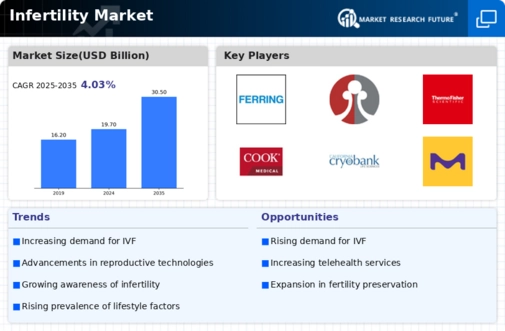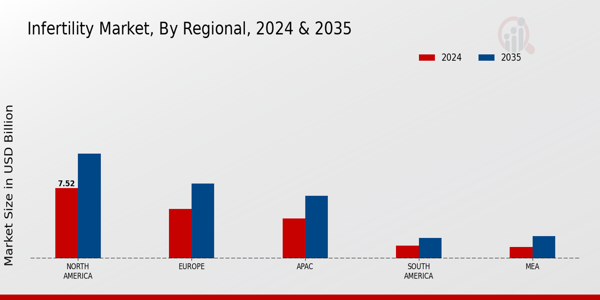Assisted Reproductive Technology
Hormone Therapy
Surgery
Fertility Preservation
Hospitals
Fertility Clinics
Home Care Settings
Female
Male
Ovulatory Disorders
Uterine or Cervical Abnormalities
Tubal Factors
Male Factor Infertility
North America
Europe
South America
Asia Pacific
Middle East and Africa
North America Outlook (USD Billion, 2019-2035)
North America Infertility Market by Treatment Type
Assisted Reproductive Technology
Hormone Therapy
Surgery
Fertility Preservation
North America Infertility Market by End User Type
Hospitals
Fertility Clinics
Home Care Settings
North America Infertility Market by Gender Type
Female
Male
North America Infertility Market by Cause of Infertility Type
Ovulatory Disorders
Uterine or Cervical Abnormalities
Tubal Factors
Male Factor Infertility
North America Infertility Market by Regional Type
US
Canada
US Outlook (USD Billion, 2019-2035)
US Infertility Market by Treatment Type
Assisted Reproductive Technology
Hormone Therapy
Surgery
Fertility Preservation
US Infertility Market by End User Type
Hospitals
Fertility Clinics
Home Care Settings
US Infertility Market by Gender Type
Female
Male
US Infertility Market by Cause of Infertility Type
Ovulatory Disorders
Uterine or Cervical Abnormalities
Tubal Factors
Male Factor Infertility
CANADA Outlook (USD Billion, 2019-2035)
CANADA Infertility Market by Treatment Type
Assisted Reproductive Technology
Hormone Therapy
Surgery
Fertility Preservation
CANADA Infertility Market by End User Type
Hospitals
Fertility Clinics
Home Care Settings
CANADA Infertility Market by Gender Type
Female
Male
CANADA Infertility Market by Cause of Infertility Type
Ovulatory Disorders
Uterine or Cervical Abnormalities
Tubal Factors
Male Factor Infertility
Europe Outlook (USD Billion, 2019-2035)
Europe Infertility Market by Treatment Type
Assisted Reproductive Technology
Hormone Therapy
Surgery
Fertility Preservation
Europe Infertility Market by End User Type
Hospitals
Fertility Clinics
Home Care Settings
Europe Infertility Market by Gender Type
Female
Male
Europe Infertility Market by Cause of Infertility Type
Ovulatory Disorders
Uterine or Cervical Abnormalities
Tubal Factors
Male Factor Infertility
Europe Infertility Market by Regional Type
Germany
UK
France
Russia
Italy
Spain
Rest of Europe
GERMANY Outlook (USD Billion, 2019-2035)
GERMANY Infertility Market by Treatment Type
Assisted Reproductive Technology
Hormone Therapy
Surgery
Fertility Preservation
GERMANY Infertility Market by End User Type
Hospitals
Fertility Clinics
Home Care Settings
GERMANY Infertility Market by Gender Type
Female
Male
GERMANY Infertility Market by Cause of Infertility Type
Ovulatory Disorders
Uterine or Cervical Abnormalities
Tubal Factors
Male Factor Infertility
UK Outlook (USD Billion, 2019-2035)
UK Infertility Market by Treatment Type
Assisted Reproductive Technology
Hormone Therapy
Surgery
Fertility Preservation
UK Infertility Market by End User Type
Hospitals
Fertility Clinics
Home Care Settings
UK Infertility Market by Gender Type
Female
Male
UK Infertility Market by Cause of Infertility Type
Ovulatory Disorders
Uterine or Cervical Abnormalities
Tubal Factors
Male Factor Infertility
FRANCE Outlook (USD Billion, 2019-2035)
FRANCE Infertility Market by Treatment Type
Assisted Reproductive Technology
Hormone Therapy
Surgery
Fertility Preservation
FRANCE Infertility Market by End User Type
Hospitals
Fertility Clinics
Home Care Settings
FRANCE Infertility Market by Gender Type
Female
Male
FRANCE Infertility Market by Cause of Infertility Type
Ovulatory Disorders
Uterine or Cervical Abnormalities
Tubal Factors
Male Factor Infertility
RUSSIA Outlook (USD Billion, 2019-2035)
RUSSIA Infertility Market by Treatment Type
Assisted Reproductive Technology
Hormone Therapy
Surgery
Fertility Preservation
RUSSIA Infertility Market by End User Type
Hospitals
Fertility Clinics
Home Care Settings
RUSSIA Infertility Market by Gender Type
Female
Male
RUSSIA Infertility Market by Cause of Infertility Type
Ovulatory Disorders
Uterine or Cervical Abnormalities
Tubal Factors
Male Factor Infertility
ITALY Outlook (USD Billion, 2019-2035)
ITALY Infertility Market by Treatment Type
Assisted Reproductive Technology
Hormone Therapy
Surgery
Fertility Preservation
ITALY Infertility Market by End User Type
Hospitals
Fertility Clinics
Home Care Settings
ITALY Infertility Market by Gender Type
Female
Male
ITALY Infertility Market by Cause of Infertility Type
Ovulatory Disorders
Uterine or Cervical Abnormalities
Tubal Factors
Male Factor Infertility
SPAIN Outlook (USD Billion, 2019-2035)
SPAIN Infertility Market by Treatment Type
Assisted Reproductive Technology
Hormone Therapy
Surgery
Fertility Preservation
SPAIN Infertility Market by End User Type
Hospitals
Fertility Clinics
Home Care Settings
SPAIN Infertility Market by Gender Type
Female
Male
SPAIN Infertility Market by Cause of Infertility Type
Ovulatory Disorders
Uterine or Cervical Abnormalities
Tubal Factors
Male Factor Infertility
REST OF EUROPE Outlook (USD Billion, 2019-2035)
REST OF EUROPE Infertility Market by Treatment Type
Assisted Reproductive Technology
Hormone Therapy
Surgery
Fertility Preservation
REST OF EUROPE Infertility Market by End User Type
Hospitals
Fertility Clinics
Home Care Settings
REST OF EUROPE Infertility Market by Gender Type
Female
Male
REST OF EUROPE Infertility Market by Cause of Infertility Type
Ovulatory Disorders
Uterine or Cervical Abnormalities
Tubal Factors
Male Factor Infertility
APAC Outlook (USD Billion, 2019-2035)
APAC Infertility Market by Treatment Type
Assisted Reproductive Technology
Hormone Therapy
Surgery
Fertility Preservation
APAC Infertility Market by End User Type
Hospitals
Fertility Clinics
Home Care Settings
APAC Infertility Market by Gender Type
Female
Male
APAC Infertility Market by Cause of Infertility Type
Ovulatory Disorders
Uterine or Cervical Abnormalities
Tubal Factors
Male Factor Infertility
APAC Infertility Market by Regional Type
China
India
Japan
South Korea
Malaysia
Thailand
Indonesia
Rest of APAC
CHINA Outlook (USD Billion, 2019-2035)
CHINA Infertility Market by Treatment Type
Assisted Reproductive Technology
Hormone Therapy
Surgery
Fertility Preservation
CHINA Infertility Market by End User Type
Hospitals
Fertility Clinics
Home Care Settings
CHINA Infertility Market by Gender Type
Female
Male
CHINA Infertility Market by Cause of Infertility Type
Ovulatory Disorders
Uterine or Cervical Abnormalities
Tubal Factors
Male Factor Infertility
INDIA Outlook (USD Billion, 2019-2035)
INDIA Infertility Market by Treatment Type
Assisted Reproductive Technology
Hormone Therapy
Surgery
Fertility Preservation
INDIA Infertility Market by End User Type
Hospitals
Fertility Clinics
Home Care Settings
INDIA Infertility Market by Gender Type
Female
Male
INDIA Infertility Market by Cause of Infertility Type
Ovulatory Disorders
Uterine or Cervical Abnormalities
Tubal Factors
Male Factor Infertility
JAPAN Outlook (USD Billion, 2019-2035)
JAPAN Infertility Market by Treatment Type
Assisted Reproductive Technology
Hormone Therapy
Surgery
Fertility Preservation
JAPAN Infertility Market by End User Type
Hospitals
Fertility Clinics
Home Care Settings
JAPAN Infertility Market by Gender Type
Female
Male
JAPAN Infertility Market by Cause of Infertility Type
Ovulatory Disorders
Uterine or Cervical Abnormalities
Tubal Factors
Male Factor Infertility
SOUTH KOREA Outlook (USD Billion, 2019-2035)
SOUTH KOREA Infertility Market by Treatment Type
Assisted Reproductive Technology
Hormone Therapy
Surgery
Fertility Preservation
SOUTH KOREA Infertility Market by End User Type
Hospitals
Fertility Clinics
Home Care Settings
SOUTH KOREA Infertility Market by Gender Type
Female
Male
SOUTH KOREA Infertility Market by Cause of Infertility Type
Ovulatory Disorders
Uterine or Cervical Abnormalities
Tubal Factors
Male Factor Infertility
MALAYSIA Outlook (USD Billion, 2019-2035)
MALAYSIA Infertility Market by Treatment Type
Assisted Reproductive Technology
Hormone Therapy
Surgery
Fertility Preservation
MALAYSIA Infertility Market by End User Type
Hospitals
Fertility Clinics
Home Care Settings
MALAYSIA Infertility Market by Gender Type
Female
Male
MALAYSIA Infertility Market by Cause of Infertility Type
Ovulatory Disorders
Uterine or Cervical Abnormalities
Tubal Factors
Male Factor Infertility
THAILAND Outlook (USD Billion, 2019-2035)
THAILAND Infertility Market by Treatment Type
Assisted Reproductive Technology
Hormone Therapy
Surgery
Fertility Preservation
THAILAND Infertility Market by End User Type
Hospitals
Fertility Clinics
Home Care Settings
THAILAND Infertility Market by Gender Type
Female
Male
THAILAND Infertility Market by Cause of Infertility Type
Ovulatory Disorders
Uterine or Cervical Abnormalities
Tubal Factors
Male Factor Infertility
INDONESIA Outlook (USD Billion, 2019-2035)
INDONESIA Infertility Market by Treatment Type
Assisted Reproductive Technology
Hormone Therapy
Surgery
Fertility Preservation
INDONESIA Infertility Market by End User Type
Hospitals
Fertility Clinics
Home Care Settings
INDONESIA Infertility Market by Gender Type
Female
Male
INDONESIA Infertility Market by Cause of Infertility Type
Ovulatory Disorders
Uterine or Cervical Abnormalities
Tubal Factors
Male Factor Infertility
REST OF APAC Outlook (USD Billion, 2019-2035)
REST OF APAC Infertility Market by Treatment Type
Assisted Reproductive Technology
Hormone Therapy
Surgery
Fertility Preservation
REST OF APAC Infertility Market by End User Type
Hospitals
Fertility Clinics
Home Care Settings
REST OF APAC Infertility Market by Gender Type
Female
Male
REST OF APAC Infertility Market by Cause of Infertility Type
Ovulatory Disorders
Uterine or Cervical Abnormalities
Tubal Factors
Male Factor Infertility
South America Outlook (USD Billion, 2019-2035)
South America Infertility Market by Treatment Type
Assisted Reproductive Technology
Hormone Therapy
Surgery
Fertility Preservation
South America Infertility Market by End User Type
Hospitals
Fertility Clinics
Home Care Settings
South America Infertility Market by Gender Type
Female
Male
South America Infertility Market by Cause of Infertility Type
Ovulatory Disorders
Uterine or Cervical Abnormalities
Tubal Factors
Male Factor Infertility
South America Infertility Market by Regional Type
Brazil
Mexico
Argentina
Rest of South America
BRAZIL Outlook (USD Billion, 2019-2035)
BRAZIL Infertility Market by Treatment Type
Assisted Reproductive Technology
Hormone Therapy
Surgery
Fertility Preservation
BRAZIL Infertility Market by End User Type
Hospitals
Fertility Clinics
Home Care Settings
BRAZIL Infertility Market by Gender Type
Female
Male
BRAZIL Infertility Market by Cause of Infertility Type
Ovulatory Disorders
Uterine or Cervical Abnormalities
Tubal Factors
Male Factor Infertility
MEXICO Outlook (USD Billion, 2019-2035)
MEXICO Infertility Market by Treatment Type
Assisted Reproductive Technology
Hormone Therapy
Surgery
Fertility Preservation
MEXICO Infertility Market by End User Type
Hospitals
Fertility Clinics
Home Care Settings
MEXICO Infertility Market by Gender Type
Female
Male
MEXICO Infertility Market by Cause of Infertility Type
Ovulatory Disorders
Uterine or Cervical Abnormalities
Tubal Factors
Male Factor Infertility
ARGENTINA Outlook (USD Billion, 2019-2035)
ARGENTINA Infertility Market by Treatment Type
Assisted Reproductive Technology
Hormone Therapy
Surgery
Fertility Preservation
ARGENTINA Infertility Market by End User Type
Hospitals
Fertility Clinics
Home Care Settings
ARGENTINA Infertility Market by Gender Type
Female
Male
ARGENTINA Infertility Market by Cause of Infertility Type
Ovulatory Disorders
Uterine or Cervical Abnormalities
Tubal Factors
Male Factor Infertility
REST OF SOUTH AMERICA Outlook (USD Billion, 2019-2035)
REST OF SOUTH AMERICA Infertility Market by Treatment Type
Assisted Reproductive Technology
Hormone Therapy
Surgery
Fertility Preservation
REST OF SOUTH AMERICA Infertility Market by End User Type
Hospitals
Fertility Clinics
Home Care Settings
REST OF SOUTH AMERICA Infertility Market by Gender Type
Female
Male
REST OF SOUTH AMERICA Infertility Market by Cause of Infertility Type
Ovulatory Disorders
Uterine or Cervical Abnormalities
Tubal Factors
Male Factor Infertility
MEA Outlook (USD Billion, 2019-2035)
MEA Infertility Market by Treatment Type
Assisted Reproductive Technology
Hormone Therapy
Surgery
Fertility Preservation
MEA Infertility Market by End User Type
Hospitals
Fertility Clinics
Home Care Settings
MEA Infertility Market by Gender Type
Female
Male
MEA Infertility Market by Cause of Infertility Type
Ovulatory Disorders
Uterine or Cervical Abnormalities
Tubal Factors
Male Factor Infertility
MEA Infertility Market by Regional Type
GCC Countries
South Africa
Rest of MEA
GCC COUNTRIES Outlook (USD Billion, 2019-2035)
GCC COUNTRIES Infertility Market by Treatment Type
Assisted Reproductive Technology
Hormone Therapy
Surgery
Fertility Preservation
GCC COUNTRIES Infertility Market by End User Type
Hospitals
Fertility Clinics
Home Care Settings
GCC COUNTRIES Infertility Market by Gender Type
Female
Male
GCC COUNTRIES Infertility Market by Cause of Infertility Type
Ovulatory Disorders
Uterine or Cervical Abnormalities
Tubal Factors
Male Factor Infertility
SOUTH AFRICA Outlook (USD Billion, 2019-2035)
SOUTH AFRICA Infertility Market by Treatment Type
Assisted Reproductive Technology
Hormone Therapy
Surgery
Fertility Preservation
SOUTH AFRICA Infertility Market by End User Type
Hospitals
Fertility Clinics
Home Care Settings
SOUTH AFRICA Infertility Market by Gender Type
Female
Male
SOUTH AFRICA Infertility Market by Cause of Infertility Type
Ovulatory Disorders
Uterine or Cervical Abnormalities
Tubal Factors
Male Factor Infertility
REST OF MEA Outlook (USD Billion, 2019-2035)
REST OF MEA Infertility Market by Treatment Type
Assisted Reproductive Technology
Hormone Therapy
Surgery
Fertility Preservation
REST OF MEA Infertility Market by End User Type
Hospitals
Fertility Clinics
Home Care Settings
REST OF MEA Infertility Market by Gender Type
Female
Male
REST OF MEA Infertility Market by Cause of Infertility Type
Ovulatory Disorders
Uterine or Cervical Abnormalities
Tubal Factors
Male Factor Infertility














Leave a Comment